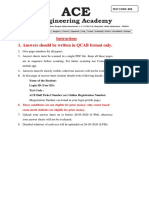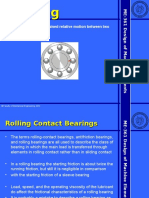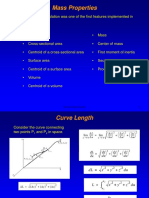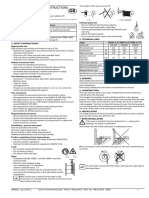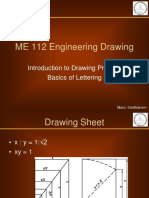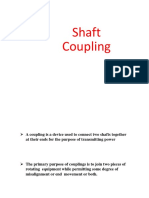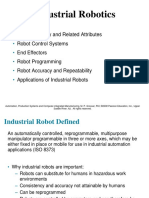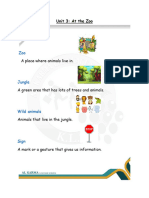Full Design of Flange Coupling
Full Design of Flange Coupling
Uploaded by
Samara AyubCopyright:
Available Formats
Full Design of Flange Coupling
Full Design of Flange Coupling
Uploaded by
Samara AyubCopyright
Available Formats
Share this document
Did you find this document useful?
Is this content inappropriate?
Copyright:
Available Formats
Full Design of Flange Coupling
Full Design of Flange Coupling
Uploaded by
Samara AyubCopyright:
Available Formats
FLANGED COUPLING: What is coupling?
A device that is used to connect two shafts together for the purpose of power transmission.
General types of couplings:
Rigid: for aligned shafts
Flexible: for non-aligned shaft
Rigid couplings:
Rigid couplings are aligned shaft couplings that are designed to draw two shafts together so that no motion can occur between them
Types of rigid couplings:
1-Flanged 2-Sleeve/Muff Coupling
3-Clamp/Split muff/Compression Coupling
Flexible couplings:
i. ii. Used to join shafts that meet at a slight angle. Angle may still change while running due to vibration or load.
Types of flexible couplings:
1-Universal Coupling2-Bushed Pin Type Coupling 3-Olbham Coupling
Flanged Coupling:
Flange:
A flange is defined as a plate type device, normally round, that is attached to the end of a pipe, fitting, valve or other object to facilitate the assembly and disassembly of a piping system.
Flange coupling:Each flange is mounted on
the shaft and keyed to it. Faces are turned up at right angle to the axis of the shafts. One of the flange has a projected portion and other has a corresponding recess. Two flanges are coupled together by bolts and nuts.
Types of flange couplings:
1-Protected type flange coupling 2-Unprotected type flange coupling 3-Marine type flange coupling
Unprotected type flange coupling:
In this type of flange coupling each shaft is keyed to the boss of a flange with a counter sunk key and the flanges are
coupled together by means of bolts (Generally 3,4,6 bolts are used.)Keys are staggered at right angle along the circumference of the shafts in order to divide weakening effect caused by key ways.
Unprotected type flange coupling:
The usual proportions for an unprotected type cast iron flange couplings, are shown as follows:
Let d = Diameter of shaft or inner diameter of hub,
D = Outer diameter of hub, d1 = Nominal or outside diameter of bolt, D1 = Diameter of bolt circle, n = Number of bolts, tf = Thickness of flange, s, b, k = Allowable shear stress for shaft, bolt and key material respectively c = Allowable shear stress for the flange material i.e. cast iron, cb, and ck = Allowable crushing stress for bolt and key
material respectively
1-Design for hub:
The hub is designed by considering it as a hollow shaft, transmitting the same torque (T) as that of a solid shaft. T=3.14/16c(D^4-d^4/D) Here D=2d and L=1.5d
2-Design for key:
3-Design for flange:
The key is designed with usual proportions and then checked for shearing and crushing stresses. The material of key is usually the same as that of shaft. The length of key is taken equal to the length of hub.
The flange at the junction of the hub is under shear while transmitting the torque. Therefore the torque transmitted, T= Circumference of hub Thickness of flange Shear stress of shaft Radius of hub =3.14Dtfcd/2=3.14D^2/2ctf Here tf=1.5d Therefore from the above relation, the induced shearing stress in the flange may be checked.
4-Design for bolts:
diameter of shaft.
The bolts are subjected to shear stress due to the torque transmitted. The number of bolts (n)depends upon the And D1=3, load on each bolt=3.14/4(d1)^2 b Total load on all the bolts=3.14/4(d1)^2 bn And torque is transmitted T=3.14/4(d1)^2bnD/2 From this equation, the diameter of bolt (d1) may be obtained. Now, the diameter of bolt may checked in crushing. Area resisting crushing of all the bolts
=nd1tf And crushing stress for all the bolts =( nd1tf) cb Torque, T=( nd1tfcb)D1/2 From this equation, the induced crushing stress in the bolts may be checked.
CALCULATIONS:
Statement:
Design flange coupling with diameter of shaft 60mm and material of shaft is high carbon steel, material of key, coupling and bolt is low carbon steel with factor of safety 2. Data: d = 50mm For high carbon steel Sy = 380 MPa For low carbon steel Sy = 300 MPa FOS = 2 Solution: For shaft: all = 0.4 Sy =0.4380 = 152 MPa all = 0.9 Sy = 0.9380 = 342 MPa nf = T all/ Td Td = 152/2 = 76 MPa Tmax = pi/16 d3 Td =pi/16 (0.06) 76= 3221.64 Nm
For hub, key,bolts,: tall = 0.4 Sy = 0.4300 = 120 MPa
all = 0.9 Sy = 0.9300 = 270 MPa nf = tall/td td = tall/ nf = 120/2 = 60 MPa d = all/ nf = 270/2 = 135 MPa 1-Design of hub: D = 2d = 260 = 120mm L = 1.5d = 1. 560 =90mm T = pi/16 tc[D^4 d^4] / D 3221640 = pi/16 tc (120^4 60^4 )/ 120 tc = 10.13 MPa<60MPa which is designed stress so design is safe here. 2-Design of key: w= d/4 = 60/4 = 15 mm t = d/6 = 60/6 = 10mm l = 1.5d = 1.560 = 90m Shear of the key: T = tkwl(d/2)w tk = T/wl (d/2) = 3221640/ 159030=79.54 Mpa Crushing of the key: ck = 2T/ tl (d/2) = 6443280/ 27000 = 238.64 MPa 3-Design for flange: tf = 0.5 d=30mm Resistive area=piD T=tc.pid^2/2.tf , tc =2T/piD^2tf=4.75MPa While for flange:
td=60MPa It means the actual shear stress(4.75MPa) in flange is less than designed(60MPa)so our design is in safe range.
4-Design for bolts: D1=3d=3(60) =180mm T=tbpi/4db^2nD1/2 db^2=8T/tb.pi.n.D1/2 db =19.49mm From Market point of view 22mm or 22M. Now, T=cbn(dbtf)D1/2 cb = 2T/n.db.tf.D1 =13.55 MPa<135MPa which is designed stress so design is safe.
Conclusion:
Coupling designed according to the above considerations will be more suitable, but the modifications according to our needs can also be made for more better results.
You might also like
- Toyota and Chassis Co - Case StudyDocument3 pagesToyota and Chassis Co - Case StudyShajara Whave UsonNo ratings yet
- Chapter 5 SensorsDocument46 pagesChapter 5 SensorsKetul ShahNo ratings yet
- Unit 7 DesignofshaftscouplingsDocument45 pagesUnit 7 DesignofshaftscouplingssuswagatNo ratings yet
- Machine Tool Gear Box DesignDocument38 pagesMachine Tool Gear Box DesignKarthikeyanRamanujam100% (1)
- Adaptive Design of Machine Tool GearboxesDocument9 pagesAdaptive Design of Machine Tool Gearboxesأحمد دعبسNo ratings yet
- 76-5-Gear BoxDocument14 pages76-5-Gear Boxrip111176100% (2)
- Knuckle Joints DesignDocument10 pagesKnuckle Joints DesignKvrd Prasad100% (1)
- 12ed11 - Advanced Machine Tool DesignDocument15 pages12ed11 - Advanced Machine Tool DesignBradeesh MoorthyNo ratings yet
- Air Craft Over Head Bin - ReportDocument5 pagesAir Craft Over Head Bin - ReportUma T ViswanathanNo ratings yet
- A ProjectDocument14 pagesA Projectajay0% (1)
- GTU-Paper-Analysis PDF All 20052019035409PMDocument9 pagesGTU-Paper-Analysis PDF All 20052019035409PMHsbsbdNo ratings yet
- Disc BrakesDocument21 pagesDisc BrakesKaide Johar BohraNo ratings yet
- Belt Drive: Prof. H. D. Mhatre 1Document22 pagesBelt Drive: Prof. H. D. Mhatre 1PHOOL KUMAR PATELNo ratings yet
- Friction Devices 19Document36 pagesFriction Devices 19mahaveer dasNo ratings yet
- Spindle DeflectionDocument8 pagesSpindle DeflectionFabrizio GrassoNo ratings yet
- MD-18 Power Screws PDFDocument4 pagesMD-18 Power Screws PDFjmartinezmoNo ratings yet
- Design Project of ShaftDocument37 pagesDesign Project of Shaftniranjanbmazire100% (1)
- 5 Machinability and Machining EconomicsDocument48 pages5 Machinability and Machining Economicssakali aliNo ratings yet
- Part 5 MT Drives and Mechanisms 1Document11 pagesPart 5 MT Drives and Mechanisms 1Zayed KhanNo ratings yet
- Spring Project PPT Final Year ProjectDocument24 pagesSpring Project PPT Final Year Projectumairismail100% (2)
- Answers Should Be Written in QCAB Format Only.: InstructionsDocument81 pagesAnswers Should Be Written in QCAB Format Only.: InstructionsSandeep PrajapatiNo ratings yet
- Me6503 Dme Unit 2 Study Notes 2015Document27 pagesMe6503 Dme Unit 2 Study Notes 2015Bala MuruganNo ratings yet
- Major Project Report On AjmDocument45 pagesMajor Project Report On AjmAwesm Rishu100% (3)
- Position TolerancesDocument79 pagesPosition TolerancesNithya PeterNo ratings yet
- Engineering Graphics Question BankDocument8 pagesEngineering Graphics Question BankSriram JNo ratings yet
- BearingsDocument26 pagesBearingsAHMED ALZAHRANINo ratings yet
- Machine Tool Engineering DesignDocument34 pagesMachine Tool Engineering DesignAshok Kumar UppariNo ratings yet
- Unit 1 Fluid Properties and Hydrostatic ForcesDocument115 pagesUnit 1 Fluid Properties and Hydrostatic ForcespoojaabanindranNo ratings yet
- Design and Analysis of Single Plate ClutchDocument3 pagesDesign and Analysis of Single Plate ClutchChandra Sekar100% (1)
- Merchant's TheoryDocument7 pagesMerchant's TheoryKannan Thankappan0% (1)
- Mass Moment of Inertia Formulas PDFDocument2 pagesMass Moment of Inertia Formulas PDFAsrar AhmedNo ratings yet
- Design and Analysis of Friction Clutch PDocument5 pagesDesign and Analysis of Friction Clutch PAgg GlezNo ratings yet
- Gear Cutting by Differential Indexing On Milling Machine Workshop Practice IIDocument6 pagesGear Cutting by Differential Indexing On Milling Machine Workshop Practice IIPartho RoychoudhuryNo ratings yet
- Knuckle Joint Stress AnalysisDocument22 pagesKnuckle Joint Stress AnalysisAshutosh girdharNo ratings yet
- Worm Gear Screw Jacks CtmuDocument92 pagesWorm Gear Screw Jacks CtmuAnonymous cPzveVRHINo ratings yet
- Couplings in MechatronicsDocument23 pagesCouplings in MechatronicsRavindra MahadeokarNo ratings yet
- 3 Gear DrivesDocument19 pages3 Gear Drivessarprajkatre143No ratings yet
- MRR in USMDocument17 pagesMRR in USMsharathwaramballi100% (1)
- Mass PropertiesDocument17 pagesMass Propertiespalaniappan_pandianNo ratings yet
- ClutchesDocument17 pagesClutchesRanjit RajendranNo ratings yet
- Haacon 4202+4585 Gebruiksaanwijzing enDocument6 pagesHaacon 4202+4585 Gebruiksaanwijzing enBasvanLeeuwen100% (2)
- ME 112 Engineering Drawing: Introduction To Drawing Practice Basics of LetteringDocument167 pagesME 112 Engineering Drawing: Introduction To Drawing Practice Basics of Letteringruya mNo ratings yet
- Motorized Smart Turning MechanismDocument3 pagesMotorized Smart Turning MechanismSUMEET SINGHNo ratings yet
- Clutch Notes Mechanical DesignDocument5 pagesClutch Notes Mechanical DesignM SiddiqueNo ratings yet
- Designing Lightweight Diesel Engine Alternator Support Bracket With Topology Optimization MethodologyDocument21 pagesDesigning Lightweight Diesel Engine Alternator Support Bracket With Topology Optimization MethodologyAhmad AmeerNo ratings yet
- Design of BrakesDocument18 pagesDesign of BrakesShahazad ShaikNo ratings yet
- Flange Coupling Lab PDFDocument25 pagesFlange Coupling Lab PDFAli Raza MalikNo ratings yet
- Macromechanics - 1: Generalized Hooke's Law For Anisotropic LaminaDocument32 pagesMacromechanics - 1: Generalized Hooke's Law For Anisotropic LaminaIntan Khalida LukmanNo ratings yet
- WireframeDocument32 pagesWireframeKamalkumar1405No ratings yet
- Design and Analysis of PROTECTED FLANGE COUPLING Solidworks 2016 and ANSYS WorkbenchDocument27 pagesDesign and Analysis of PROTECTED FLANGE COUPLING Solidworks 2016 and ANSYS Workbenchamu100% (1)
- Thermal Analysis of Ic Engine Piston Usi PDFDocument3 pagesThermal Analysis of Ic Engine Piston Usi PDFCristianNo ratings yet
- Plant Layout 2Document80 pagesPlant Layout 2tadiwosNo ratings yet
- Student Copy-Manufacturing Process SelectionDocument49 pagesStudent Copy-Manufacturing Process SelectionAnishMendisNo ratings yet
- Laser Engineered Net ShapingDocument2 pagesLaser Engineered Net ShapingDevadattNo ratings yet
- ME FinalDocument81 pagesME FinalAnkit DahiyaNo ratings yet
- Presentation On Wire EdmDocument33 pagesPresentation On Wire EdmArpit HalaniNo ratings yet
- Brake DesignDocument47 pagesBrake DesignSouravSawNo ratings yet
- Blobby ObjectsDocument15 pagesBlobby Objectslarenjose2007No ratings yet
- Coupling Lec3Document47 pagesCoupling Lec3Ahmed ArslanNo ratings yet
- Full Design of Flange CouplingDocument41 pagesFull Design of Flange CouplingAasawari Mahagaonkar0% (1)
- Coupling # 2016 E.CDocument49 pagesCoupling # 2016 E.CmulukenuniNo ratings yet
- Shaw AnswerDocument100 pagesShaw AnswerWTVCNo ratings yet
- Concrete Technologypart 1Document8 pagesConcrete Technologypart 1Marmik JavareNo ratings yet
- 20bce2958 Transport VPNDocument9 pages20bce2958 Transport VPNPATNAM VENKATA SAI ISHAN 20BCT0014No ratings yet
- Sertifikat Halal BPJPH QL FoodDocument14 pagesSertifikat Halal BPJPH QL Foodade ismailNo ratings yet
- Radioactive Radon ReportDocument2 pagesRadioactive Radon Reportapi-397961257No ratings yet
- Homework - 1Document1 pageHomework - 1Gobind GaleeyNo ratings yet
- Industrial RoboticsDocument45 pagesIndustrial Roboticshimanshu singhNo ratings yet
- Cannabis CareDocument125 pagesCannabis Careketamint90% (10)
- Test Bank For Environment and You 1st Edition ChristensenDocument12 pagesTest Bank For Environment and You 1st Edition ChristensenPeggy Gebhart100% (44)
- Ages 5Document6 pagesAges 5pravinNo ratings yet
- Bujji ResumeDocument2 pagesBujji ResumeAnonymous 2RvlriENo ratings yet
- A Visit From The Goon Squad (Excerpt)Document15 pagesA Visit From The Goon Squad (Excerpt)VintageAnchor60% (5)
- Test 2 Model 3 English 3ac First TermDocument2 pagesTest 2 Model 3 English 3ac First Termaymanaymanch100No ratings yet
- Dissolution MethodsDocument248 pagesDissolution MethodsAnzhela GrigoryanNo ratings yet
- Lecture Notes: II B. Tech I Semester (JNTUA-R19)Document209 pagesLecture Notes: II B. Tech I Semester (JNTUA-R19)vulusuluvinayNo ratings yet
- Unaudited Audited: (Amounts in Philippine Peso)Document40 pagesUnaudited Audited: (Amounts in Philippine Peso)Louie SalazarNo ratings yet
- XxamajabDocument2 pagesXxamajabMeeNo ratings yet
- Scoping Report FormatDocument12 pagesScoping Report FormatJona100% (1)
- HP Printers - Device Types For SAP Printing - HP® Customer SupportDocument21 pagesHP Printers - Device Types For SAP Printing - HP® Customer SupportvegspaceNo ratings yet
- DBMS2 Computerized Medical Record Management SystemDocument28 pagesDBMS2 Computerized Medical Record Management SystemSharlyn Theresa LazadoNo ratings yet
- E2 Knockout Drum PDFDocument2 pagesE2 Knockout Drum PDFKyaw Kyaw AungNo ratings yet
- Aftercooler Water PlumbingDocument3 pagesAftercooler Water Plumbingtechnicaldept.mtkrNo ratings yet
- Give Me Five 2Document16 pagesGive Me Five 2merna naiemNo ratings yet
- UntitledDocument2 pagesUntitledPrashant TambeNo ratings yet
- ASTRONOMICA Manilius Volume 1Document189 pagesASTRONOMICA Manilius Volume 1Humberto BrumNo ratings yet
- Final Report On City Development and Slum Upgradation Strategy of BengaluruDocument64 pagesFinal Report On City Development and Slum Upgradation Strategy of BengaluruKavya KaladharanNo ratings yet
- PMI ProcessGroupDocument47 pagesPMI ProcessGroupmuruga100% (1)
- CH 10 Special and Combo Journals and Voucher Sys PDFDocument41 pagesCH 10 Special and Combo Journals and Voucher Sys PDFAira Nhaira MecateNo ratings yet
- Yfs20501p Practical 4Document16 pagesYfs20501p Practical 4rishabh bhardwajNo ratings yet




















